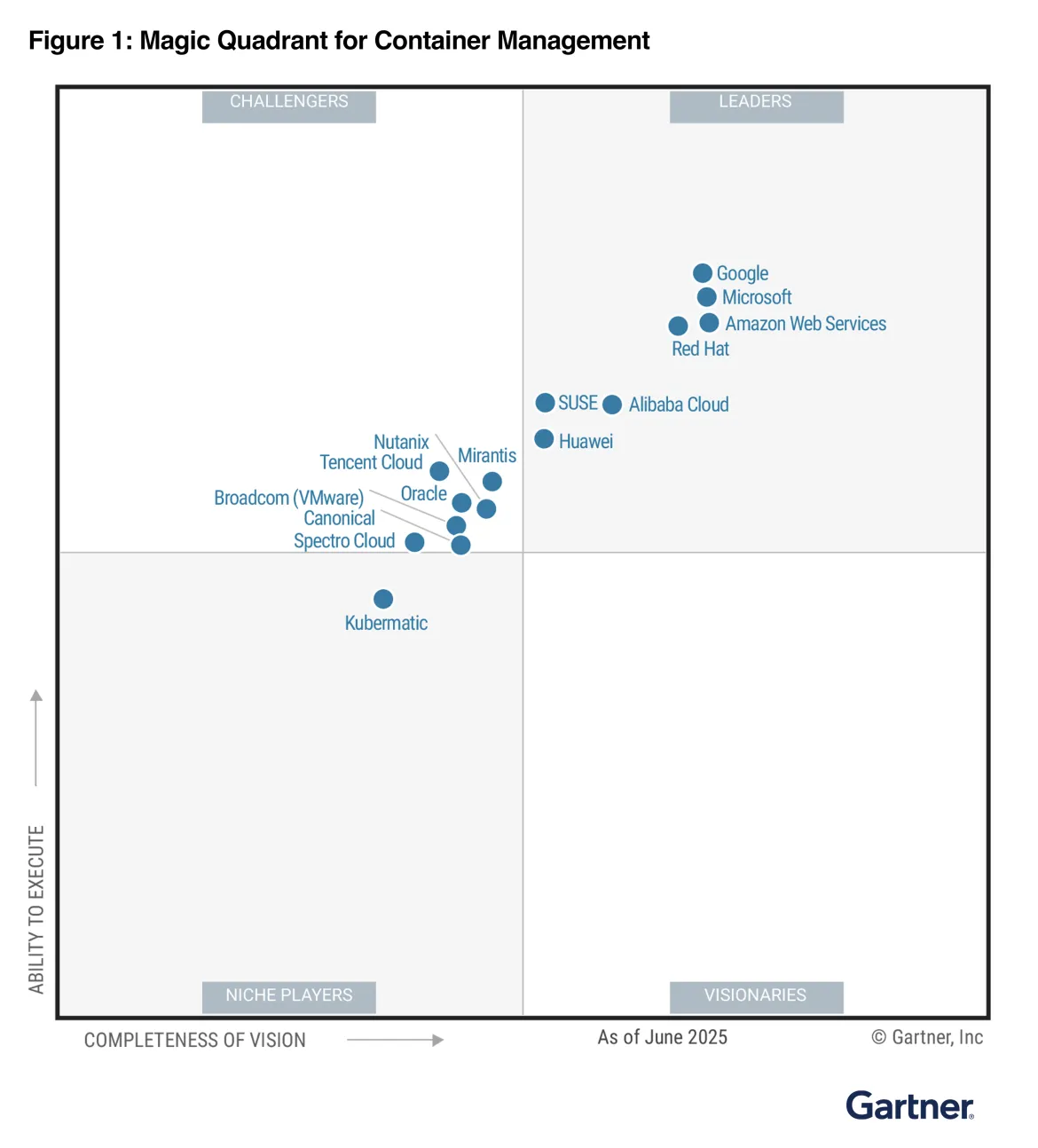This week we announced that for the third consecutive year, Red Hat has been named a Leader in the Gartner® Magic Quadrant™ for Container Management. We’re thrilled by this recognition and believe it represents continued validation of Red Hat OpenShift’s strong execution and strategy for delivering an industry leading application platform across hybrid environments from the data center, to the cloud, and to the edge.
Red Hat OpenShift is recognized for its ability to execute and completeness of vision. Red Hat’s investments in OpenShift as a platform for AI workloads, and in building AI capabilities directly into the product to make users’ jobs easier. We believe it is also reflected in Red Hat’s position in the Gartner Magic Quadrant.
OpenShift provides a comprehensive application platform with container management capabilities, including support for virtual machine workloads and AI-powered services.

What is the Gartner Magic Quadrant?
Magic Quadrant reports are a culmination of rigorous, fact-based research in specific markets, providing a wide-angle view of the relative positions of the providers in markets where growth is high and provider differentiation is distinct. Providers are positioned into four quadrants: Leaders, Challengers, Visionaries and Niche Players. Leaders execute well against their current vision and are well positioned for tomorrow. The research enables you to get the most from market analysis in alignment with your unique business and technology needs.
How was the Magic Quadrant judged? What criteria were used?
Gartner defines container management as offerings that support the deployment and operation of containerized workloads and associated resources. It uses a combination of technologies (many open source) that enable agile application deployments and infrastructure modernization. Delivery methods include stand-alone software or as a service.
Associated technologies include orchestration and scheduling, container runtime, service discovery and registration, artifact registry, routing and networking, service catalog that contains and displays application and infrastructure artifacts, management user interface, and API access to the associated resources. Container management automates the provisioning, operation and life cycle management of containerized workloads at scale. Centralized governance and security policies are used to manage container workloads and associated resources. Container management supports the requirements of modern applications (also refactoring legacy applications), including platform engineering, cloud management and continuous integration/continuous delivery (CI/CD) pipelines. Benefits include improved agility, elasticity and access to innovation.
According to Gartner, the Gartner Container Management capabilities inclusion criteria are:
- Container infrastructure — Provides enterprise-grade management of containers across on premises, cloud and/or edge locations (Container infrastructure also provides tools for integrated fleet management, including life cycles and configurations for large numbers of container orchestration clusters potentially sourced from multiple providers.)
- Managed provisioning and updates — Automates provisioning and update of container management functions and infrastructure
- Platform engineering support — Provides functions needed to deliver a self-service container platform using product management practices
- Application platform capabilities — Provides application development and DevOps capabilities to accelerate the delivery of applications using containers with CI/CD workflows
- Policy management and governance capabilities
- Security functions, including protection of container runtimes and securing container image supply chain
- Infrastructure software, including support for hypervisor-based virtual machine and host operating systems
- Storage and data protection services for stateful containerized applications
- Extensibility traits to adapt platforms to support diverse use cases (e.g., HPC, AI/ML, Edge, etc.)
- Serverless container instances or Kubernetes services that abstracts the underlying infrastructure details
Red Hat OpenShift has built its strategy around being an application development platform built on container management. In our opinion, this strategy helped us in getting recognized again as a Leader in this Gartner Magic Quadrant and fuels our growth and innovation of the OpenShift platform.
Why is this significant to us?
According to Gartner, Leaders execute well against their current vision and are well positioned for tomorrow. We believe Gartner is one of the most recognized technology analyst firms in the IT space and we feel, having been recognized as a Leader validates not only the current capabilities of Red Hat OpenShift, but also Red Hat’s vision for evolving the solution to best meet the needs of our customers in the future.
This report follows the Gartner recognition of Red Hat as a Leader in the recent 2025 Gartner Magic Quadrant for Cloud-Native Application Platforms. We believe this dual recognition validates our strategic evolution in the positioning of OpenShift as an Application Platform to help accelerate modern and secure application development and delivery for our customers.
Learn more about Red Hat OpenShift for Container Management
A full copy of the Gartner Magic Quadrant on Container Management can be downloaded here.
Gartner Disclaimer:
Gartner does not endorse any vendor, product or service depicted in its research publications, and does not advise technology users to select only those vendors with the highest ratings or other designation. Gartner research publications consist of the opinions of Gartner’s research organization and should not be construed as statements of fact. Gartner disclaims all warranties, expressed or implied, with respect to this research, including any warranties of merchantability or fitness for a particular purpose.
GARTNER is a registered trademark and service mark of Gartner and Magic Quadrant is a registered trademark of Gartner, Inc. and/or its affiliates in the U.S. and internationally and are used herein with permission. All rights reserved.
This graphic was published by Gartner, Inc. as part of a larger research document and should be evaluated in the context of the entire document. The Gartner document is available upon request from Red Hat.
product trial
Red Hat OpenShift Container Platform | 제품 체험판
저자 소개
Sara Buffington is a Product Marketing Manager at Red Hat, specializing in the marketing and positioning of Red Hat OpenShift cloud services.
Debbie Margulies is a principal product marketing manager for Red Hat OpenShift and has been at Red Hat since 2019 through the acquisition of StackRox.
채널별 검색
오토메이션
기술, 팀, 인프라를 위한 IT 자동화 최신 동향
인공지능
고객이 어디서나 AI 워크로드를 실행할 수 있도록 지원하는 플랫폼 업데이트
오픈 하이브리드 클라우드
하이브리드 클라우드로 더욱 유연한 미래를 구축하는 방법을 알아보세요
보안
환경과 기술 전반에 걸쳐 리스크를 감소하는 방법에 대한 최신 정보
엣지 컴퓨팅
엣지에서의 운영을 단순화하는 플랫폼 업데이트
인프라
세계적으로 인정받은 기업용 Linux 플랫폼에 대한 최신 정보
애플리케이션
복잡한 애플리케이션에 대한 솔루션 더 보기
가상화
온프레미스와 클라우드 환경에서 워크로드를 유연하게 운영하기 위한 엔터프라이즈 가상화의 미래

